Augie Pabst, Behind the Wheel
By Robert Birmingham
Dalton Watson Fine Books, March 2016
ISBN 978-1-85443-277-3
280mm by 230mm
Hardbound with dust jacket
367 pages
500 color and B&W photos
$79.00 USD, plus shipping
$99 signed by Pabst
Book Review by Pete Vack
Robert Birmingham’s book begins very softly, gently leading us into the life of Augie Pabst. A very brief look at his childhood and education; sparse race reports, a photo or two of Pabst Motors in 1956, racing an AC Bristol, and an affair with a Ferrari (sn 0612).
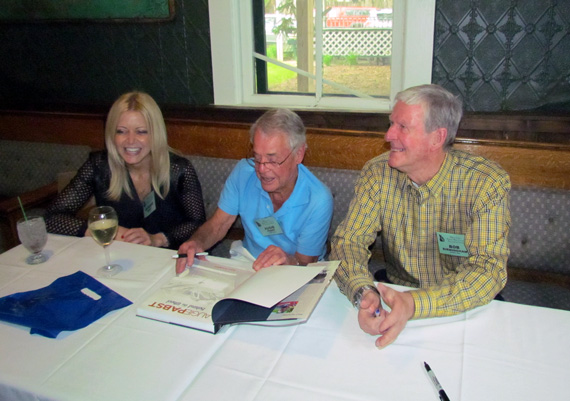
May 12, 2016 Road America. Augie Pabst signs copies of his biography. Left is Pabst’s daughter Eugénie, at right author Bob Birmingham.
Then August Uihlein (the Uihlein family was behind the Schlitz beer company; his father was Pabst, his mother a Uinlein heir) Pabst himself begins to add to the text, commenting and recalling events, people and places that bring depth and color to what might otherwise be merely a blow by blow narrative of a lot of race car events. Birmingham also gathers the comments of friends and race drivers such as Bill Wuestfhoff and Harry Heuer.
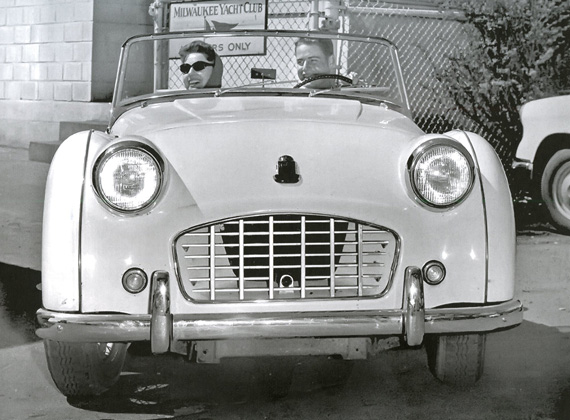
Pabst poses in a Triumph for a dealership ad. His first race was in May 1956 with a Triumph TR3; he was third in class and as he recalled, a bit cocky.
The book quickly blossoms into one of the most satisfying racing biographies this reviewer has ever read. It is a remarkable compilation of newspaper and magazine reports, first-hand accounts, outstanding photography from the Pabst collection (and others) and the seemingly enthusiastic help of Pabst himself.
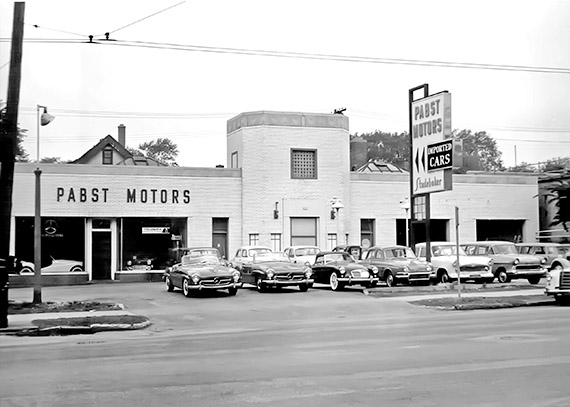
1956 was a very good time to establish a foreign car dealership in a major U.S. city. Pabst handled Mercedes, BMC and Triumph.
In addition Tom Schultz was instrumental with editing, proofreading, and providing additional photos and material. The large, high quality Dalton Watson format allows the best presentation of the 500 photos which fully cover Pabst’s racing career. The narrative and images don’t stop when Pabst retired from racing in 1966; the book tracks his later career as a vintage race driver and collector, as well as a comeback as a race driver in the less stressful Sports 2000 series in the mid-1980s.
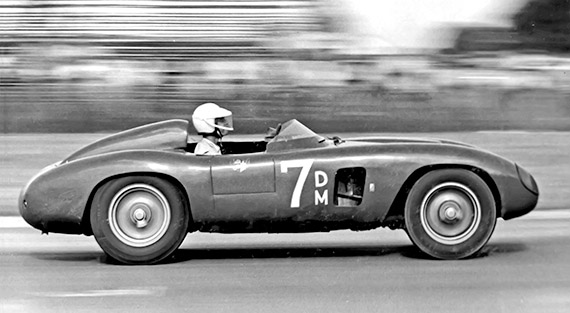
In 1958, after a few seasons running ACs and production cars, Pabst bought the ex- Ebby Lunken Ferrari 2.5 liter Testa Rossa, S/N 0612 and began to make a name for himself.
Also from the Pabst scrapbook are the dozens of newspaper and magazine clippings which are reproduced in a sharp, easily readable size and add depth to the biography. Almost buried in the clippings are two hilarious and telling chronicles by Augie’s then-wife Marcia who traveled with him to the Bahamas and Le Mans. They are behind-the-scenes commentaries which highlighted how difficult it was to travel, the hurdles they faced and the camaraderie that was prevalent among the race drivers and team members.
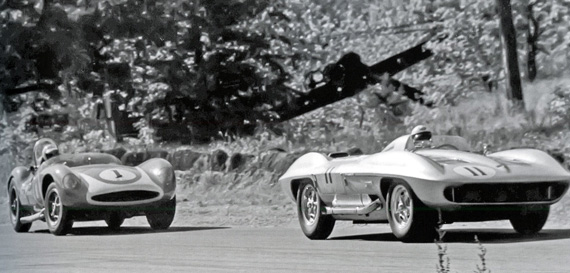
Pabst drove for Meister Bräuser in the Scarab in 1959 and 1960, here winning the 1960 June Sprints at Road America. He would pass Dr. Dick Thompson in the one-off Sting Ray. Meister Bräuser was a competitor of Pabst Blue Ribbon, and the success of a Pabst at the wheel of a Meister Bräuser-sponsored car did not sit well with the board of the Peter Hand Brewery (who produced Meister Bräuser beer).Pierre Perrin photo.
Birmingham is well placed to have created this particular book. He worked for Pabst Motors for ten years, raced himself, and witnessed a great many Pabst victories. He later retired as a Vice President of Firstar Bank.
The book almost didn’t happen. Initially, Birmingham, Augie’s wife Joan and son August III (who today runs Pabst Racing) kept the book a secret from Pabst, who they feared might put a stop to the entire effort. Writes Birmingham, “…once on board his vast recollection of people, cars and events were invaluable.”
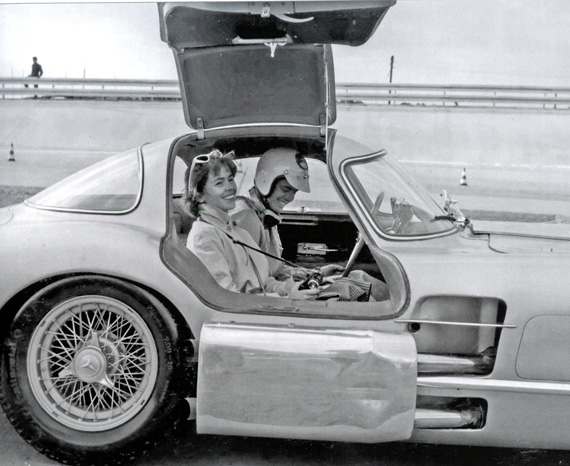
1960 was a busy year. Pabst left Road America and traveled to Le Mans to drive the new Ferrari 250 SWB for Chinetti. Pabst and Ed Hugus finished 7th overall. He was then given the red carpet treatment at Daimler Benz, where he drove the W-196 Grand Prix Mercedes and the Uhlenhaut 300SLR coupe. Marcia Pabst enjoys the ride.
The author brings us Augie in almost full measure but note the title; Augie Pabst Behind the Wheel. While the racing efforts are related in detail, little is mentioned of his personal life or business life; just enough to provide a background. Born in 1933, Pabst was the grandson of Frederick Pabst, son of the Great Lakes steamship captain who started putting the family name on beer in 1889. After the early death of his father, Augie was raised by his grandparents.
Although Pabst Blue Ribbon beer sales reached a peak of 15.6 million barrels in 1978, not generally known was the fact that in the mid-1950s the company was going through some tough times. The Pabst family had lost control and financial problems nearly ruined the business. This lack of direct family involvement in the business allowed Augie to go into the imported car business (at a very opportune time) and racing naturally followed.
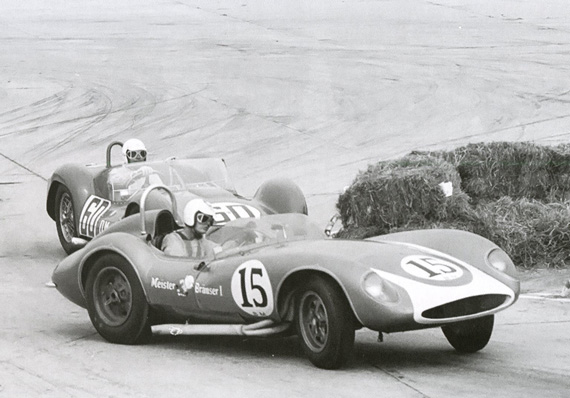
Pabst battles with his friend Walt Hansgen at Montgomery in August of 1960. Hansgen won after the Scarab had difficulties. Pabst was devastated by Hansgen’s death in April of 1966. AAVR photo.
In a very short career, Pabst won 24 features, fifteen in major events and had significant placings at Sebring and Le Mans. He drove sports cars, formula cars, vintage cars, and even stock cars and was perhaps one of the most underrated drivers of the era.
It wasn’t until 1966, after several serious accidents and a couple miserable seasons that Augie considered retiring from racing. At the same time Jim Windham, who was now making Pabst profitable again, offered Augie a position at the Pabst Brewery. The conditions were tough; Windham told Augie he’d have to not only quit racing but sell his dealership. Pabst did both. “I wasn’t going to waste my time on him and let him get broke-up again,” said Windham.
But it had been wild ten years Behind the Wheel.
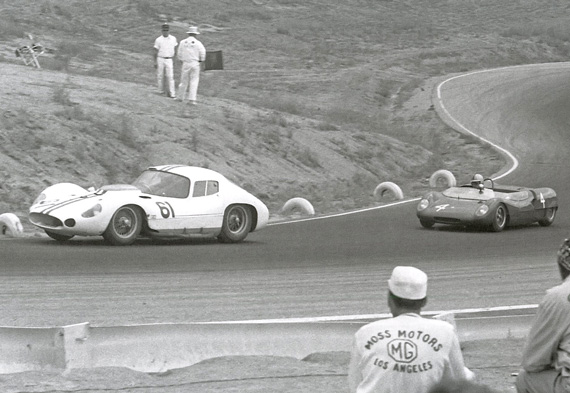
In 1962 Pabst drove for the Cunningham team. At Riverside in October, his Maserati T151 is pressed by Jack Brabham in a Lotus 23. It was the trailing days of the front engined race cars. The next year Pabst would drive for the Mecom team in a Lotus 19. Allen R. Kuhn photo.
Read More: Augie Pabst Connections
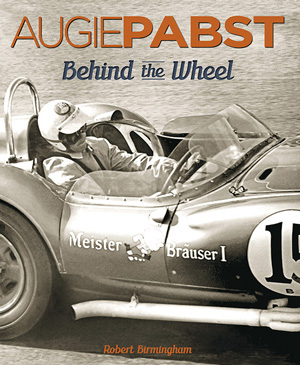
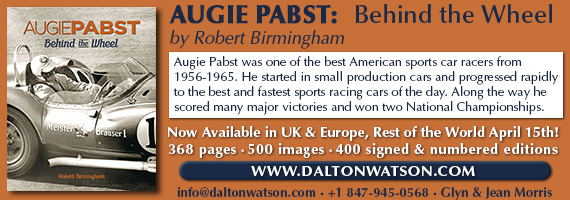
Great review of a great and long overdue book. But in those day [1960] it was Sting Ray of course, not Stingray.
Willem, You have me there, and I was there! Thanks for the correction.
Pete
Au contraire! Yes, when referring to production Corvettes from 1963 to 1967 it is Sting Ray, two words. However, when referring to the Stingray Racer that Dick Thompson drove, Stingray is one word. In 1968 the model name was dropped but it returned in 1969 as one word, Stingray. That carried through to the 1976 model, but the Stingray name vanished in 1977, only to return once again as one word on the 2014 Corvette to present.
I thought that the beer was Meister Brau and the car was Meister Bauser.
Dear Randy! Contre au contraire! Looking at Karl Ludvigsen’s 1973 book on the Corvettes, it shows that he persists in calling the car the Sting Ray racer. In the booklet The first 10 years of Road America the car is referred to “the silvery Sting Ray” and one of the captions mentions “Sting Ray Sizzler.” In a July 2001 article in R&T by John Lamm, Dick Thompson is reunited with his old mount [still called the Sting Ray] and the photos show a Corvette Sting Ray logo on its nose. Of course this was a later addition since the car never featured one on its nose in 1960. It did have one on the left tail section, but none of my photos show that part of the Sting Ray.
Karl was wrong, IMHO. If you look at early photos of the car (1959) there is a Stingray (one word) emblem on the side of each front fender, just aft of the wheel opening. The emblem has the shape of a Stingray (one word when discussing Myliobatoidei, the ocean variety) and the word Stingray below. See pg. 57 of “Corvette Thunder” by Dave Friedman for an example of the emblem (Friedman also incorrectly uses the two-word Sting Ray when referring to the racer). Also see Peter Brock’s “Corvette Sting Ray” book of last year where he correctly refers to the race car as the Stingray Racer, and uses the correct Sting Ray when referring to the 1963-67 production cars (he also explains the difference on pg. 87). Let’s face it, many editors didn’t pay attention to such details so we’ve seen it both ways over the years and while editor of Vette magazine I once had a conversation with Larry Shinoda about it and he in his own funny way talked about Bill Mitchell and how important details like this were to Mitchell and said the race car was “Stingray.” I rest my case.
Randy, I understand your reasoning. However, without going through every entry list of events in which Bill Mitchell’s Sting Ray was entered in 1959 and 1960 [and I am sure they show the same spelling], and whatever the stylistic emblem on the side of the car was, it was Mitchell who entered the car since he owned it. The 1960 Road America 500 program list it as: #11, entrant: Wm L. Mitchell, Birmingham, Mich. drivers: Richard K. Thompson and James R. Johnston, Car: Sting Ray. Now the organizers would not make this up and the spelling of the entered name of the car had to come from Mitchell himself, whatever Shinoda’s recollections are many years after the facts. I rest my case as well.
Good to see a photo of Sir Jack Brabham.
I want to thank Pete for using one of the few images I have in Pabst book. And proper credit too, life is good. Being a visual guy for me to actually read a book, besides the captions, is a feat. I have thoroughly enjoyed the first third that I have read, so far. Bob Birmingham’s words and research opened my eyes to the fact that Augie is a great driver and not just a playboy acting like a driver. Well done.
Allen R. Kuhn
how can you tell which term is used when someone is speaking?
Toly, none of us can! But the original race programs from 1959 and 1960 and how the car was entered by Bill Mitchell would be a good first step.
Holy
As a one-time DJ I could probably speak in a way that would allow you to tell…but that hardly is worth noting. The snimal seems to always be written as a single word. But, for example, the Jerry Burton biography of Arkus-Duntov lists it in the index and text as two words. His statement indicates that Mitchell “named it the Sting Ray, even though it was a shark that inspired it.” And the timing seems to go back to the “Q” body placed over the SS mule (1959?). The inference is that the name and as two words was used when the decision was made to race that car to “test the public reaction to this revolutionary new design theme.”
So, Randy, if Freidman was wrong…so is Burton. But unfortunately the only picture of the SS in his book is taken from the front and the only badging visible is the crossed flags on the nose. Nothing on the front fenders, so likely taken before the decision to race. While the book does list art credits at the end there is no notation for this photo (page 270). It certainly looks like it was done by GM as a studio shot, but it is conjecture as to when it was taken. So…is there verification that the photos you mention with the “Stingray” on the fenders was indeed in 59?
I suppose, like any marketers, they fooled around with both versions, or maybe came to realize that the sea creature was named with a single word. And unless someone does indeed go through the entry lists (and we all know how wrong those can be) it does appear the initial intent was to use two words.
Typo…Toly is anything but “holy”
Regardless, a treasure of a race car and production car. Peter Brock gets way too little credit for his involvement. Without Peter and Phil Remington, we may not have had most of the drama that formed this great era of racing.
I have a 61 corvair wagon which was once owned by August U Pabst. I have been told it was used for some sort of promotions. This is not a scam, I have the registration with his name and address. I would like to find out more history on this auto. Thank you
I seem to remember Augie Pabst driving his car into our swimming pool … imagine he might remember that …